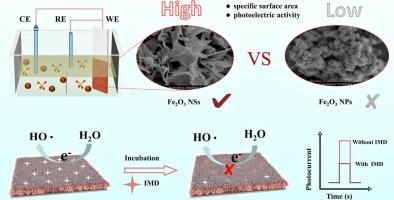超薄Fe2O3纳米片增强分子印迹光电化学传感器用于吡虫啉农药的超灵敏检测
IF 4.1
3区 化学
Q1 CHEMISTRY, ANALYTICAL
引用次数: 0
摘要
本文将Fe2O3超薄纳米片(Fe2O3 NSs)与分子印迹技术相结合,制备了一种新型分子印迹光电化学(MIP-PEC)传感器,用于吡虫啉(IMD)的超灵敏检测。令人印象深刻的是,通过电沉积在氧化铟锡(ITO)衬底上合成了二维Fe2O3 NSs。得益于其窄带隙和大比表面积,Fe2O3纳米颗粒(~ 600 μA)的光电电荷分离效率显著提高,显著提高了MIP-PEC传感器的灵敏度。此外,利用电聚合技术在Fe2O3 NSs/ITO表面形成了分子印迹的IMD聚合物膜,大大提高了所提出传感器的检测选择性。结果表明,所设计的MIP-PEC传感器具有宽线性响应(5 nM ~ 120 μM)、低检测限(1.02 nM)和长存储时间(4周后信号仅下降5.03%),成功地实现了对IMD的超灵敏、特异和可靠的检测。该方法测定水果和环境水样中IMD的回收率和相对标准偏差(RSD)分别为92.0% ~ 108.0%和3.2% ~ 4.9%,验证了该方法的野外适用性。显然,本研究为将先进的光敏材料与分子印迹技术相结合,协同提高PEC的分析性能建立了一个新的范例。本文章由计算机程序翻译,如有差异,请以英文原文为准。

Ultrathin Fe2O3 nanosheet-enhanced molecularly imprinted photoelectrochemical sensor for ultrasensitive detection of imidacloprid pesticide
Herein, a novel molecularly imprinted photoelectrochemical (MIP-PEC) sensor was fabricated through integrating the ultrathin nanosheets of Fe2O3 (Fe2O3 NSs) with molecular imprinting technology for the ultrasensitive detection of imidacloprid (IMD). Impressively, the two-dimensional Fe2O3 NSs was synthesized on an indium‑tin oxide (ITO) substrate by electrodeposition. Benefiting from its narrow bandgap and large specific surface area, the photogenerated charge separation efficiency of Fe2O3 NSs (∼ 600 μA) was remarkably enhanced compared to that of the commercial Fe2O3 nanoparticles (∼150 μA), which significantly improved the sensitivity of the developed MIP-PEC sensor. Furthermore, the electropolymerization technique was used to form a molecularly imprinted polymer film of IMD on the surface of Fe2O3 NSs/ITO, substantially increased the detection selectivity of the proposed sensor. As a result, the designed MIP-PEC sensor successfully achieved ultrasensitive and specific as well as reliable detection of IMD with a broad linear response (5 nM ∼ 120 μM), low detection limit (1.02 nM) and long storage time (the signal only decreased by 5.03 % after 4 weeks of storage). The recoveries and relative standard deviation (RSD) for the determination of IMD in fruits and environmental water samples by the obtained MIP-PEC were in the range of 92.0 % ∼ 108.0 % and 3.2 % ∼ 4.9 % respectively, validating its field-applicability. Obviously, this work established a novel paradigm for synergistic enhancement of the analysis performance of PEC through integration of the advanced photosensitive materials with molecular imprinting technology.
求助全文
通过发布文献求助,成功后即可免费获取论文全文。
去求助
来源期刊
CiteScore
7.80
自引率
6.70%
发文量
912
审稿时长
2.4 months
期刊介绍:
The Journal of Electroanalytical Chemistry is the foremost international journal devoted to the interdisciplinary subject of electrochemistry in all its aspects, theoretical as well as applied.
Electrochemistry is a wide ranging area that is in a state of continuous evolution. Rather than compiling a long list of topics covered by the Journal, the editors would like to draw particular attention to the key issues of novelty, topicality and quality. Papers should present new and interesting electrochemical science in a way that is accessible to the reader. The presentation and discussion should be at a level that is consistent with the international status of the Journal. Reports describing the application of well-established techniques to problems that are essentially technical will not be accepted. Similarly, papers that report observations but fail to provide adequate interpretation will be rejected by the Editors. Papers dealing with technical electrochemistry should be submitted to other specialist journals unless the authors can show that their work provides substantially new insights into electrochemical processes.

 求助内容:
求助内容: 应助结果提醒方式:
应助结果提醒方式:


